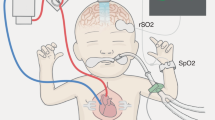Abstract
Palliative surgery is often performed in the treatment of congenital heart disease. Two representative palliative procedures are the systemic pulmonary shunt and pulmonary artery banding. Dramatic changes in cerebral hemodynamics may occur in these operations due to changes in the pulmonary-to-systemic blood flow ratio and systemic oxygenation. However, there seem to be almost no studies evaluating them. Accordingly, we evaluated cerebral perfusion by transcranial Doppler ultrasonography and cerebral oxygenation by near infrared spectroscopy during these procedures. In the post hoc analysis of a previous prospective observational study, cerebral blood flow velocities of the middle cerebral artery measured by transcranial Doppler were compared between the start and end of surgery as were the pulsatility index and resistance index. The cerebral oxygenation values were also compared between the start and end of surgery. Twenty-two infants with systemic pulmonary shunt and 20 infants with pulmonary artery banding were evaluated. There were no significant differences of the flow velocities between the start and end of surgery in either procedure. The pulsatility index significantly increased after pulmonary artery banding, which may compete with the increase in cerebral perfusion due to the increase in systemic blood flow. The cerebral oxygenation decreased in both procedures, possibly due to an increase in body temperature. Arterial oxygen saturation was almost the same before and after both procedures. Contrary to our expectation, the changes in cerebral hemodynamics in the palliative operations were small if the management of physiological indices such as arterial oxygen saturation was properly performed during the procedures.

Similar content being viewed by others
References
Zhu S, Sai X, Lin J, Deng G, Zhao M, Nasser MI, Zhu P (2020) Mechanisms of perioperative brain damage in children with congenital heart disease. Biomed Pharmacother 132:110957
Finucane E, Jooste E, Machovec KA (2020) Neuromonitoring modalities in pediatric cardiac anesthesia: a review of the literature. J Cardiothorac Vasc Anesth 34:3420–3428
Patel PM, Drummond JC, Lemkuil BP (2020) Cerebral physiology and the effets of anesthetic drugs. In: Gropper MA (ed) Miller’s anesthesia. Elsevier, Philadelphia, pp 294–332
Rhee CJ, da Costa CS, Austin T, Brady KM, Czosnyka M, Lee JK (2018) Neonatal cerebrovascular autoregulation. Pediatr Res 84:602–610
Votava-Smith JK, Statile CJ, Taylor MD, King EC, Pratt JM, Nelson DP, Michelfelder EC (2017) Impaired cerebral autoregulation in preoperative newborn infants with congenital heart disease. J Thorac Cardiovasc Surg 154:1038–1044
Yamamoto M, Mori T, Toki T, Itosu Y, Kubo Y, Yokota I, Morimoto Y (2021) The relationships of cerebral and somatic oxygen saturation with physiological parameters in pediatric cardiac surgery with cardiopulmonary bypass: analysis using the random-effects model. Pediatr Cardiol 42:370–378
Yamamoto M, Toki T, Kubo Y, Hoshino K, Morimoto Y (2022) Age difference of the relationship between cerebral oxygen saturation and physiological parameters in pediatric cardiac surgery with cardiopulmonary bypass: analysis using the random-effects model. Pediatr Cardiol. https://doi.org/10.1007/s00246-022-02889-x
Kussman BD, Gauvreau K, DiNardo JA, Newburger JW, Mackie AS, Booth KL, del Nido PJ, Roth SJ, Laussen PC (2007) Cerebral perfusion and oxygenation after the Norwood procedure: comparison of right ventricle-pulmonary artery conduit with modified Blalock-Taussig shunt. J Thorac Cardiovasc Surg 133:648–655
Lamba A, Joshi RK, Joshi R, Agarwal N (2020) Near-infrared spectroscopy: an important tool during the blalock-taussig shunt. Ann Card Anaesth 23:92–94
Schwartz JM, Vricella LA, Jeffries MA, Heitmiller ES (2008) Cerebral oximetry guides treatment during Blalock-Taussig shunt procedure. J Cardiothorac Vasc Anesth 22:95–97
Hoffman GM, Ghanayem NS, Tweddell JS (2005) Noninvasive assessment of cardiac output. Semin Thorac Cardiovasc Surg Pediatr Card Surg Annu 8:12–21
Cui B, Ou-Yang C, Xie S, Lin D, Ma J (2020) Age-related cerebrovascular carbon dioxide reactivity in children with ventricular septal defect younger than 3 years. Paediatr Anaesth 30:977–983
Kaltman JR, Di H, Tian Z, Rychik J (2005) Impact of congenital heart disease on cerebrovascular blood flow dynamics in the fetus. Ultrasound Obstet Gynecol 25:32–36
Man T, He Y, Zhao Y, Sun L, Liu X, Ge S (2017) Cerebrovascular hemodynamics in fetuses with congenital heart disease. Echocardiography 34:1867–1871
Yagi Y, Yamamoto M, Saito H, Mori T, Morimoto Y, Oyasu T, Tachibana T, Ito YM (2017) Changes of cerebral oxygenation in sequential glenn and fontan procedures in the same children. Pediatr Cardiol 38:1215–1219
Yoshitani K, Kawaguchi M, Ishida K, Maekawa K, Miyawaki H, Tanaka S, Uchino H, Kakinohana M, Koide Y, Yokota M, Okamoto H, Nomura M (2019) Guidelines for the use of cerebral oximetry by near-infrared spectroscopy in cardiovascular anesthesia: a report by the cerebrospinal Division of the Academic Committee of the Japanese Society of Cardiovascular Anesthesiologists (JSCVA). J Anesth 33:167–196
Szczapa T, Karpiński Ł, Moczko J, Weindling M, Kornacka A, Wróblewska K, Adamczak A, Jopek A, Chojnacka K, Gadzinowski J (2013) Comparison of cerebral tissue oxygenation values in full term and preterm newborns by the simultaneous use of two near-infrared spectroscopy devices: an absolute and a relative trending oximeter. J Biomed Opt 18:87006
Ziehenberger E, Urlesberger B, Binder-Heschl C, Schwaberger B, Baik-Schneditz N, Pichler G (2018) Near-infrared spectroscopy monitoring during immediate transition after birth: time to obtain cerebral tissue oxygenation. J Clin Monit Comput 32:465–469
Author information
Authors and Affiliations
Contributions
Conceptualization: [MY, YM]; Methodology: [MY, YM]; Formal analysis and investigation: [YT, YMIY, YM]; Writing—original draft preparation: [YT, YM]; Writing—review and editing: [NK, SW, KH].
Corresponding author
Ethics declarations
Competing interests
The authors declare no competing interests.
Additional information
Publisher's Note
Springer Nature remains neutral with regard to jurisdictional claims in published maps and institutional affiliations.
Rights and permissions
Springer Nature or its licensor holds exclusive rights to this article under a publishing agreement with the author(s) or other rightsholder(s); author self-archiving of the accepted manuscript version of this article is solely governed by the terms of such publishing agreement and applicable law.
About this article
Cite this article
Takeda, Y., Yamamoto, M., Hoshino, K. et al. Changes in Cerebral Hemodynamics During Systemic Pulmonary Shunt and Pulmonary Artery Banding in Infants with Congenital Heart Disease. Pediatr Cardiol 44, 695–701 (2023). https://doi.org/10.1007/s00246-022-02999-6
Received:
Accepted:
Published:
Issue Date:
DOI: https://doi.org/10.1007/s00246-022-02999-6




